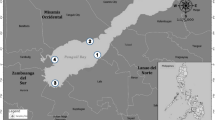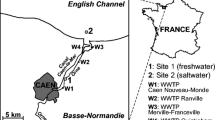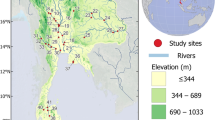Abstract
The objective of this study was to determine the suitability of Hyalella azteca, Chironomus tentans and Lumbriculus variegatus as representative species for the assessment of sediment toxicity. Ten chemicals were tested at the U.S. EPA Environmental Research Laboratory-Duluth, always using H. azteca and C. tentans and, occasionally, L. variegatus. The exposures were water-only, flow-through tests with measured chemical concentrations, which were conducted for 10 days in Lake Superior water. Chemicals tested included five metals (copper, lead, zinc, nickel, cadmium) and five pesticides (chlorpyrifos, dieldrin, p,p′-DDD, p,p′-DDE, p,p′-DDT). The amphipod was quite sensitive to the metals, while the midge often was exceptionally sensitive to the pesticides. No one of the three species was most (or least) sensitive to the toxicants. Toxicity of the contaminants to the three species was compared to the genus mean acute and chronic data found in U.S. EPA Water Quality Criteria (WQC) documents, as well as information from the AQUIRE database. The results of these comparisons indicated that the three species reasonably represent the range of sensitivities of other aquatic test species, and occasionally are among the most sensitive species when compared to others in the WQC database.
Similar content being viewed by others
References
Ankley GT, Schubauer-Berigan MK, Dierkes JR (1991a) Predicting the toxicity of bulk sediments to aquatic organisms with aqueous test fractions: Pore water versus elutriate. Environ Toxicol Chem 10:1359–1366
Ankley GT, Phipps GL, Leonard EN, Benoit DA, Mattson VR, Kosian PA, Cotter AM, Dierkes JR, Hansen DJ, Mahony JD (1991b) Acid volatile sulfide as a factor mediating cadmium and nickel bioavailability in contaminated sediments. Environ Toxicol Chem 10:1299–1307
Ankley GT, Cook PM, Carlson AR, Call DJ, Swenson JA, Corcoran HF, Hoke RA (1992) Bioaccumulation of PCBs from sediments by oligochaetes and fishes: Comparison of laboratory and field studies. Can J Fish Aquatic Sci 49:2080–2085
Ankley GT, Benoit DA, Hoke RA, Leonard EN, West CW, Phipps GL, Mattson VR, Anderson LA (1993) Development and evaluation of test methods for benthic invertebrates and sediments: Effects of flow rate and feeding on water quality and exposure conditions. Arch Environ Contam Toxicol 25:12–19
Ankley GT, Call DJ, Cox JS, Kahl MD, Hoke RA Kosian PA (1994) Organic carbon partitioning as a basis for predicting the toxicity of chlorpyrifos in sediments. Environ Toxicol Chem 13:621–626
American Society for Testing and Materials (1992) New standard guide for conducting solid phase sediment toxicity tests with freshwater invertebrates. ASTM Annual Book of Standards, Vol 11.04, E1383–92. American Society for Testing and Materials, Philadelphia, PA
Benoit DA, Mattson VR, Olson DL (1982) A continuous-flow minidiluter system for toxicity testing. Water Res 16:457–464
Borgmann V, Ralph KM, Norwood WP (1989) Toxicity test procedures for Hyalella azteca and chronic toxicity of cadmium and pentachlorophenol to H. azteca, Gammarus fasciatus, and Daphnia magna. Arch Environ Contam Toxicol 18:756–764
Finney DJ (1971) Probit analysis, 3rd ed. Cambridge University Press, Cambridge, 333 pp
Hamilton MA, Russo RC, Thurston RV (1977) Trimmed Spearman-Karber method for estimated median lethal concentrations in toxicity bioassays. Environ Sci Technol 7:714–719 Correction: 12:417 (1978)
Hoke RA, Kosian PA, Ankley GT, Cotter AM, VanderMeiden FM, Phipps GL, Durhan EJ (1994a) Check studies with Hyalella azteca and Chironomus tentans in support of a sediment quality criterion for dieldrin. Environ Toxicol Chem (in press)
Hoke RA, Ankley GT, Cotter AM, Goldenstein T, Kosian PA, Phipps GL, VanderMeiden FM (1994b) Evaluation of equilibrium partitioning theory for predicting the acute toxicity of field-collected sediments contaminated with DDT, DDE and DDD to the amphipod, Hyalella azteca. Environ Toxicol Chem 13:157–166
Nebeker AV, Cairns MA, Gakstatter JH, Malueg KW, Schuytema GS, Krawcyzk DF (1984) Biological methods for determining toxicity of contaminated sediments to invertebrates. Environ Toxicol Chem 3:617–630
Phipps GL, Ankley GT, Benoit DA, Mattson VR (1993) Use of the aquatic oligochaete Lumbriculus variegatus for assessing the toxicity and bioaccumulation of sediment-associated contaminants. Environ Toxicol Chem 12:269–279
Schubauer-Berigan MK, Ankley GT (1991) The contribution of ammonia, metals and nonpolar organic compounds to the toxicity of sediment interstitial water from an Illinois River tributary. Environ Toxicol Chem 10:925–940
Schubauer-Berigan MK, Dierkes JR, Monson PD, Ankley GT (1993) The pH-dependent toxicity of Cd, Cu, Ni, Pb and Zn to Ceriodaphnia dubia, Pimephales promelas, Hyalella azteca, and Lumbriculus variegatus. Environ Toxicol Chem 12:1261–1266
US Environmental Protection Agency (1992) Tiered testing issues for freshwater and marine sediments-Workshop proceedings. U.S. Environmental Protection Agency, Office of Science and Technology, Washington, DC
US Environmental Protection Agency (1989) Short-term methods for estimating the chronic toxicity of effluents and receiving waters to freshwater organisms, EPA/600/3–85/104. U.S. Environmental Protection Agency, Cincinnati, OH
US Environmental Protection Agency (1986a) Ambient water quality criteria for chlorpyrifos. EPA/440/5–86–005 NTIS, Springfield, VA
US Environmental Protection Agency (1986b) Ambient water quality criteria for nickel. EPA/440/5–86–004 NTIS, Springfield, VA
US Environmental Protection Agency (1984a) Ambient water quality criteria for copper. EPA/440/5–84–031 NTIS, Springfield, VA
US Environmental Protection Agency (1984b) Ambient water quality criteria for cadmium. EPA/440/5–84–032 NTIS, Springfield, VA
US Environmental Protection Agency (1984c) Ambient water quality criteria for lead, EPA/440/5–84–027 NTIS, Springfield, VA
US Environmental Protection Agency (1984d) AQUIRE: Aquatic information retrieval toxicity data base. EPA/600/8–84–021 NTIS, Springfield, VA
US Environmental Protection Agency (1980a) Ambient water quality criteria for zinc, EPA/440/5–80–079 NTIS, Springfield, VA
US Environmental Protection Agency (1980b) Ambient water quality criteria for DDT, EPA/440/5–80–038 NTIS, Springfield, VA
US Environmental Protection Agency (1980c) Ambient water quality criteria for aldrin/dieldrin. EPA/440/5–80–019 NTIS, Springfield, VA
West CW, Mattson VR, Leonard EN, Phipps GL, Ankley GT (1993) Comparison of the relative sensitivity of three benthic invertebrates to copper contaminated sediments from the Keweenaw Waterway. Hydrobiologia 262:57–63
Author information
Authors and Affiliations
Rights and permissions
About this article
Cite this article
Phipps, G.L., Mattson, V.R. & Ankley, G.T. Relative sensitivity of three freshwater benthic macroinvertebrates to ten contaminants. Arch. Environ. Contam. Toxicol. 28, 281–286 (1995). https://doi.org/10.1007/BF00213103
Received:
Revised:
Issue Date:
DOI: https://doi.org/10.1007/BF00213103




